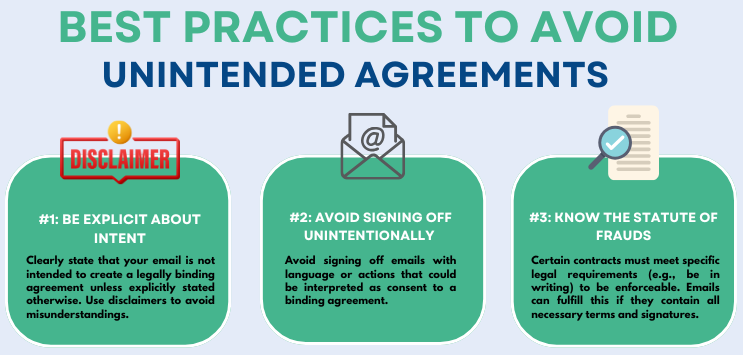Can Your Email Seal the Deal? Understanding Emails in Commercial Contracts
In the thick of a negotiation, sending bullet points and terms back and forth, you’re probably not thinking about whether your emails would constitute a binding contract.
But they can.
Email is the go-to communication tool for startups and small businesses. It’s a fast, efficient, and informal way to communicate in business. And that’s why it’s vital to know when your emails are more than just words on a screen.
When Does an Email Become a Contract?
Let’s start with the basics. An enforceable contract requires (at least) three basic elements:
An offer and acceptance.
A mutual agreement on essential terms.
A signature.
Thanks to laws like the Electronic Signatures in Global and National Commerce Act (E-SIGN) and the Uniform Electronic Transactions Act (UETA), an email can check all three boxes:
An email exchange can outline the offer and acceptance.
The terms written in the emails can memorialize the mutual agreement.
A typed name at the bottom of an email (even an auto-signature) can count as an electronic signature if it’s clear that the sender intended it to be binding
Avoiding Unintended Agreements
Most of us use email informally. But courts don’t always see it that way. To avoid accidentally forming a binding agreement, consider these best practices:
1. Be Explicit About Intent
If you’re negotiating but don’t want to commit yet, say so. Include a disclaimer in your emails stating that discussions are exploratory and not intended to create a binding agreement unless formalized in a signed document. Something like:
“This email is for discussion purposes only and does not constitute a binding agreement.”
This small addition can save you from significant misunderstandings later.
2. Watch What You Sign—Even Digitally
Your automatic email signature could be seen as your consent. If you’re not ready to finalize terms, avoid signing off with language that could be interpreted as binding, such as “Agreed” or “Confirmed.” Even the simple act of typing your name at the end can be enough in some cases.
3. Understand the Statute of Frauds
Certain types of contracts—like those involving real estate or agreements that can’t be completed within a year—must be in writing to be enforceable. Emails can meet this requirement if they contain the necessary terms and signatures. Be cautious when discussing such deals over email.
Best Practices to Avoid Unintended Agreements
Post-Contract Emails: New Legal Risks
The binding power of emails doesn’t stop once the contract is signed. Emails sent after the agreement can:
Modify terms if they demonstrate mutual agreement.
Act as waivers, excusing the other party from certain obligations.
Serve as evidence of a new agreement to settle disputes.
This means a casual “Sure, no problem” reply could unintentionally waive your rights under the original agreement.
How to Protect Your Business
1. Train Your Team
Make sure your employees and managers understand the legal implications of emails. Train them to be mindful about what they write and how they sign off, especially during negotiations.
2. Use Disclaimers Strategically
Incorporate disclaimers into your email footers to clarify that email communications aren’t binding agreements unless stated otherwise.
3. Consult Counsel Early
When in doubt, get legal advice. If a negotiation is heating up or terms are evolving quickly over email, it’s time to loop in your attorney.
5 Key Steps to Avoid Legal Risks with your Business Email
The Bottom Line
Emails are an incredible tool for startups and small businesses. But like any tool, they come with risks if not used properly. Treat email communication with the same care you’d give to drafting a formal contract. That little “Send” button could have bigger implications than you realize.
Are your emails working for you—or against you? If you’re unsure, it’s time to take a closer look at your email policies.


